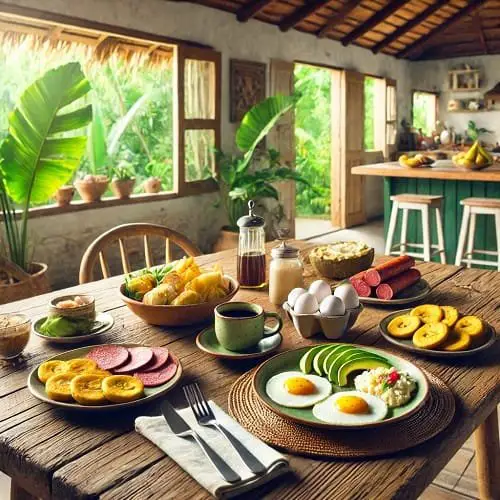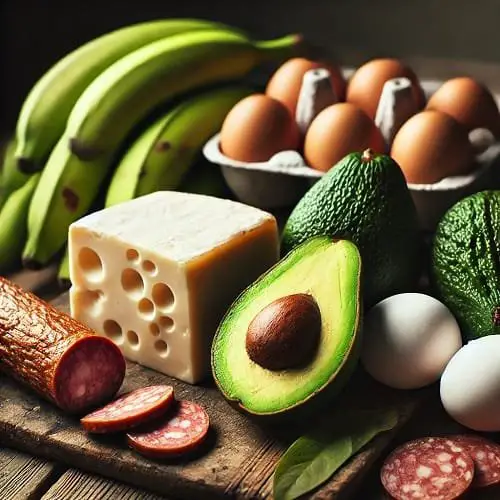Jump to Section
There’s nothing quite like starting your day with the rich, savory flavors of a Dominican breakfast. Imagine the mouthwatering scent of fried cheese, the satisfying taste of mashed plantains, and the comforting warmth of freshly brewed Dominican coffee. Whether you’re waking up in the heart of the Caribbean or trying this delicious meal from the comfort of your own kitchen, a Dominican breakfast is an experience you won’t want to miss.
Dominican breakfasts are a delightful mix of flavors and textures, blending sweet, savory, and hearty ingredients that provide the perfect start to your day. This meal is not only a reflection of the country’s rich culinary traditions, but it also brings a sense of community and joy to the table. With dishes like mangu (mashed plantains), fried cheese, salami, and eggs, Dominican breakfasts are full of vibrant and fresh ingredients that leave you energized and ready for whatever the day may bring.
Trying a Dominican breakfast is a must for anyone looking to explore a new culture through food. It’s more than just a meal; it’s a celebration of flavors that can bring warmth to your morning. Whether you’re a seasoned traveler or simply a food enthusiast, this breakfast is a great way to start your day on the right note – full of energy, flavor, and excitement.
What is a Dominican Breakfast?

A Dominican breakfast is a vibrant and flavorful meal that combines hearty ingredients, rich traditions, and a deep connection to the island’s culture. This first meal of the day is a reflection of the Dominican Republic’s agricultural abundance, blending tropical produce with simple yet satisfying ingredients. From the creamy texture of mangu (mashed plantains) to the crispy delight of fried cheese, Dominican breakfasts are designed to nourish both body and soul.
One of the key aspects of a Dominican breakfast is its variety of ingredients. Plantains are the star of many dishes, with mangu being the most iconic. This mashed plantain dish is often paired with eggs, cheese, and salami—ingredients that provide a wonderful balance of savory, salty, and creamy flavors. Fried cheese, or queso frito, is another essential element, adding a crispy texture that complements the soft and fluffy mangu. In addition to these main components, you’ll often find avocado, fried eggs, and sometimes even hot chocolate or freshly brewed coffee to wash it all down. These ingredients are not just about flavor, but about creating a meal that sustains you through a busy day.
In Dominican culture, breakfast is more than just a meal; it is a time for family and community. In many households, breakfast is the first chance of the day to sit together, share stories, and bond over delicious food. This meal is enjoyed with warmth and joy, often served in a relaxed and social setting. It’s a cherished tradition that highlights the importance of family, togetherness, and the island’s rich culinary history.
A Dominican breakfast, therefore, is not only an essential part of the day—it’s an experience that brings people together and showcases the country’s love for food, culture, and tradition.
Key Ingredients of a Traditional Dominican Breakfast

A traditional Dominican breakfast is built around a handful of key ingredients that are not only essential to the meal but also reflect the rich agricultural landscape of the Dominican Republic. These ingredients come together to create a satisfying, energizing breakfast that can be customized to suit individual tastes. Let’s explore these key components in more detail:
Mangu (Mashed Plantains)
Mangu, or mashed plantains, is the heart of any Dominican breakfast. Plantains are a staple food on the island, prized for their versatility and satisfying texture. The preparation of mangu is simple: green plantains are boiled, mashed, and then served with a bit of butter, salt, and sometimes a touch of garlic. Its soft, velvety texture makes it the perfect base for any Dominican breakfast.
There are many variations of mangu. It can be served plain or paired with eggs, cheese, and salami. For instance, mangu with eggs is a classic combination, where the plantains are served with scrambled eggs on top. Another popular version is mangu with cheese—typically a generous portion of fried cheese, adding a delightful crunch to the dish. Whatever the variation, mangu is the perfect way to kick off the day with a comforting and hearty meal.
Salami (Dominican Sausage)
Salami, or salami dominicano, is a beloved breakfast addition that brings a savory, spiced flavor to the table. This Dominican sausage is slightly different from other types of salami you may be familiar with—it’s thicker and often more heavily seasoned. To prepare it, slices of salami are fried until crispy on the edges, releasing a rich, flavorful aroma. It complements the mild taste of mangu perfectly, providing a bold contrast to the softness of the plantains.
Salami is a common sight on Dominican breakfast plates and adds a hearty element to the meal. Its slightly smoky flavor pairs exceptionally well with the creamy texture of eggs and the fried cheese, making it an essential part of the traditional Dominican morning feast.
Eggs and Cheese
Eggs are a key component in many Dominican breakfasts, and they’re often served scrambled or fried. Whether paired with mangu or eaten on their own, eggs provide a protein-packed addition to the meal. They’re typically served with cheese, which is another staple ingredient.
The cheese used in Dominican breakfasts is often queso frito, or fried cheese. This type of cheese is firm and can withstand frying without melting away. The result is a crispy exterior with a soft, slightly salty interior. The combination of eggs and queso frito is both delicious and filling, offering a perfect balance of flavors. This dish is often enjoyed alongside mangu or in a breakfast sandwich, creating a satisfying, wholesome start to the day.
Fried Cheese (Queso Frito)
Fried cheese plays a crucial role in many Dominican breakfasts. It’s typically made with firm, salty cheese varieties that hold up well to frying. Queso frito is golden brown on the outside, with a warm, soft center. The crispy texture of the cheese adds a delightful contrast to the softer mangu and eggs, creating a more complex and satisfying dish.
To make queso frito, the cheese is sliced into thick pieces and then fried until crispy. It’s often served alongside mangu, eggs, and salami, but can also be enjoyed on its own as a side dish. The saltiness of the fried cheese complements the sweet and starchy mangu, making it an integral part of the Dominican breakfast experience.
Other Add-ons
In addition to the core ingredients, a traditional Dominican breakfast often includes a variety of add-ons that enhance both the flavor and nutritional value of the meal. One popular addition is avocado, which provides a creamy, refreshing element to balance out the richness of the other ingredients. Slices of ripe avocado are often placed on the side of the plate or added on top of mangu for extra texture.
Fried eggs are another common component, cooked to your preference—whether soft and runny or crispy on the edges. The addition of these eggs boosts the protein content and adds richness to the dish.
Sometimes, Dominican breakfasts may also include a side of yuca (cassava), fried to golden perfection, or a light drink like moro (rice and beans) to complement the meal. These small touches make the breakfast even more satisfying and ensure that every bite delivers a burst of Caribbean flavor.
Each of these ingredients contributes to making the Dominican breakfast a memorable and delicious experience. Whether you enjoy the meal simply or indulge in all the variations, these key components come together to create a balanced, satisfying, and hearty start to the day.
Popular Dominican Breakfast Dishes

Dominican breakfasts come in many delicious forms, with each dish offering a unique blend of flavors and textures that cater to various tastes. Whether you’re craving something hearty, light, or traditional, there’s a Dominican breakfast dish that will make your morning unforgettable. Let’s take a look at some of the most beloved dishes that define a Dominican breakfast.
Mangu con Los Tres Golpes (Mashed Plantains with the Three Hits)
Mangu con Los Tres Golpes is arguably the most iconic Dominican breakfast dish. The name translates to “Mashed Plantains with the Three Hits,” and it’s a beloved morning meal in many Dominican households. The dish features mangu, which is mashed green plantains, served alongside three essential “hits” or components: salami, fried cheese, and eggs. These three items come together to create a hearty, balanced meal that is both savory and satisfying.
Why is it such a traditional and beloved dish? Well, it’s not just about the flavor—it’s about the experience. Mangu con Los Tres Golpes reflects the Dominican love for simple, comforting food made with local ingredients. Each component complements the others: the soft, sweet plantains, the savory and crispy fried cheese, the richness of eggs, and the spiciness of salami. Together, they create a well-rounded meal that provides the energy needed to kickstart the day.
El Pan con Mantequilla y Queso
For those who prefer something simpler, Pan con Mantequilla y Queso is a classic choice. This dish features fresh, soft bread slathered with creamy butter and topped with queso fresco (fresh cheese). The combination of warm, buttery bread and the slightly salty cheese makes for a delicious, comforting breakfast. It’s a lighter option, often enjoyed with a side of fresh fruit or a hot cup of Café Dominicano (Dominican coffee). This simple yet flavorful dish is perfect for those who want a quick breakfast that still satisfies.
Yuca con Mojo
Yuca con Mojo is another favorite side dish that pairs wonderfully with other Dominican breakfast items. Yuca, or cassava, is a starchy root vegetable that is boiled until tender and served with mojo—a tangy, garlicky sauce made with olive oil, garlic, and citrus. The combination of yuca’s mild flavor and the zesty mojo sauce creates a delightful contrast, and it adds a bit of variety to the usual mangu and eggs. Yuca con Mojo is often served alongside fried cheese, eggs, and salami, making it a great accompaniment to any traditional Dominican breakfast.
Omelette Dominicano
The Omelette Dominicano is a Dominican twist on the classic omelette, but with a few local touches. Unlike the typical Western omelette, which is often made with just eggs and fillings like cheese or vegetables, the Dominican version includes ingredients like salami, onions, bell peppers, and tomatoes. The result is a flavorful, colorful omelette that’s hearty enough to serve as a complete breakfast on its own. This dish showcases the vibrant flavors of Dominican cuisine and is a great option for those who want a protein-packed start to their day.
Beverages
No Dominican breakfast is complete without a delicious beverage to accompany it. The most popular drink is Café Dominicano, or Dominican coffee, which is known for its rich, bold flavor. It’s often served strong and sweet, with a hint of cinnamon. Dominican coffee is an integral part of breakfast culture, enjoyed by locals and visitors alike.
In addition to coffee, fresh juices are a common choice. Jugo de Naranja (orange juice) and jugo de chinola (passion fruit juice) are two of the most popular options. These juices are refreshing and packed with vitamins, making them the perfect complement to a hearty breakfast.
For those who prefer something warmer, hot chocolate is another traditional drink enjoyed with breakfast. Dominican hot chocolate is rich and creamy, often made with milk, sugar, and a bit of cinnamon for extra flavor. It’s the perfect drink for cooler mornings or when you’re craving something sweet and comforting.
These popular Dominican breakfast dishes each offer something unique, whether it’s the rich, savory flavor of mangu with salami or the refreshing zest of yuca con mojo. Whether you’re looking for something light or hearty, these dishes showcase the diversity and deliciousness of Dominican cuisine, making them the perfect way to start your day.
RELATED POSTS
10 Irresistible Italian Breakfast Foods You Must Try
How to Cook Smoked Turkey Wings: A Step-by-Step Guide
From Starter to Slice: The Ultimate Pain au Levain Recipe for Home Bakers
What is Hokkaido Milk Tea? A Creamy Delight
Can You Make Mac n Cheese Without Milk? 3 Amazing Recipes
How to Prepare a Delicious Dominican Breakfast at Home

Preparing a Dominican breakfast at home is easier than you might think, and it’s a great way to bring the flavors of the Caribbean to your kitchen. Whether you’re making Mangu con Los Tres Golpes (Mashed Plantains with the Three Hits) or a simpler breakfast, here’s a step-by-step guide on how to recreate this delicious meal from scratch.
Step-by-Step Instructions:
- Making Mangu (Mashed Plantains):
- Ingredients: 2 green plantains, water, salt, butter.
- Instructions:
- Peel the plantains by cutting off both ends and making a shallow slit along the length of the plantain. Carefully remove the peel.
- Cut the plantains into chunks and place them in a pot of water. Boil until soft (around 15-20 minutes).
- Drain the water and mash the plantains using a potato masher. Add butter and a pinch of salt for flavor. For extra creaminess, you can add a little bit of the boiling water or milk.
- Serve the mangu hot, and it’s ready to pair with eggs, cheese, and salami!
- Peel the plantains by cutting off both ends and making a shallow slit along the length of the plantain. Carefully remove the peel.
- Ingredients: 2 green plantains, water, salt, butter.
- Frying Salami:
- Ingredients: Dominican salami (or regular salami), oil.
- Instructions:
- Slice the salami into rounds (about 1/4-inch thick).
- Heat a little oil in a pan and fry the salami slices until crispy and golden on both sides.
- Remove from the pan and set aside.
- Slice the salami into rounds (about 1/4-inch thick).
- Ingredients: Dominican salami (or regular salami), oil.
- Frying Cheese (Queso Frito):
- Ingredients: Firm cheese (queso fresco, queso de freír), oil.
- Instructions:
- Slice the cheese into thick pieces.
- Heat oil in a pan and fry the cheese slices until they are golden brown and crispy on both sides.
- Once fried, place the cheese on a paper towel to remove excess oil.
- Slice the cheese into thick pieces.
- Ingredients: Firm cheese (queso fresco, queso de freír), oil.
Tips for Enhancing Flavor:
- Seasonings: Dominican breakfast dishes are known for their use of garlic, onions, and bell peppers. Add a little garlic powder to the mangu, or sauté some onions and bell peppers in the same pan where you fry the salami for added flavor.
- Avocado: Don’t forget to serve fresh avocado on the side for a creamy contrast to the savory components of the meal.
- Coffee: Brew a strong cup of Café Dominicano (Dominican coffee) to complete the meal and enjoy an authentic experience.
Useful Tips for Authenticity:
- Use the right cheese: For the best taste, use queso frito or a firm, salty cheese like queso de freír, which holds up well when fried.
- Plantains: Make sure to use green plantains for the mangu, as ripe plantains (the yellow ones) will not give the same texture.
- Fresh Ingredients: Freshness is key in Dominican cooking. Whenever possible, use fresh produce, especially for the plantains and avocado.
By following these simple steps, you can bring the essence of a Dominican breakfast into your own home, creating a meal that’s both authentic and delicious.
The Health Benefits of a Dominican Breakfast

A Dominican breakfast is not only delicious but also offers a balanced and nutritious start to your day. The meal typically includes a mix of proteins, carbs, and fats, making it a well-rounded option that keeps you energized throughout the morning.
One of the core components of a Dominican breakfast is mangu, which is made from plantains. Plantains are a great source of complex carbohydrates and provide fiber, making them excellent for digestion. They also contain potassium, which is vital for heart health and maintaining fluid balance in the body.
The addition of eggs brings in essential proteins that help in muscle repair and growth, as well as healthy fats that keep you feeling full longer. The fried cheese (queso frito) also contributes a good amount of protein and fat, offering a deliciously satisfying element to the meal.
Another key ingredient is avocado, which is rich in heart-healthy fats, vitamins, and minerals. It adds a creamy texture to the breakfast and helps improve the absorption of nutrients from the other foods.
All these ingredients together create a nutrient-packed breakfast that’s not only filling but also helps regulate energy levels, supporting both physical and mental activity throughout the day. This combination makes a Dominican breakfast an ideal choice for a nutritious and satisfying morning meal.
Frequently Asked Questions (FAQ)
What is the most popular Dominican breakfast?
The most popular Dominican breakfast is Mangu con Los Tres Golpes (mashed plantains with salami, fried cheese, and eggs). This dish is beloved for its balance of flavors and textures, offering a satisfying start to the day.
Can I make a Dominican breakfast vegetarian?
Yes, you can make a vegetarian version of a Dominican breakfast by skipping the salami and using plant-based alternatives for the cheese. Simply enjoy the mangu with eggs, avocado, and fried cheese.
What drinks are typically served with a Dominican breakfast?
The most common drinks are Café Dominicano (Dominican coffee), fresh orange juice, or passion fruit juice. Hot chocolate is also a popular option, especially in cooler weather.
How do I make mangu without it being too mushy?
To avoid mushy mangu, make sure to cook the plantains until they are tender but not overly soft. After mashing, add a little of the cooking water at a time to reach the right consistency. Also, avoid over-mashing the plantains.
Is Dominican breakfast spicy?
Generally, Dominican breakfast dishes aren’t very spicy. However, some variations may include a hint of spice, especially if hot sauce or peppers are added to dishes like eggs or salami.
Can I make mangu with ripe plantains?
Mangu is traditionally made with green plantains, which have a firmer texture and neutral flavor. Using ripe (yellow) plantains will result in a sweeter, softer dish, which is not typical for this breakfast.
What kind of cheese is used in Dominican breakfast?
Queso Frito (fried cheese) is commonly used, made from a firm, salty cheese that holds its shape when fried. Queso fresco (fresh cheese) can also be used in other variations.
Can I add vegetables to a Dominican breakfast?
Yes! Vegetables like onions, peppers, and tomatoes are commonly sautéed and added to eggs or mangu. They can enhance flavor and add extra nutrients to your meal.
What is the best way to store leftover mangu?
Leftover mangu can be stored in an airtight container in the refrigerator for up to 2-3 days. To reheat, simply add a little water or butter and warm it up on the stove.
Is mangu gluten-free?
Yes, mangu is naturally gluten-free, as it is made from plantains, which do not contain gluten. This makes it a suitable breakfast option for people with gluten sensitivities.
Can I substitute plantains for other ingredients in mangu?
While plantains are the core ingredient in mangu, you could substitute them with other starchy vegetables like sweet potatoes for a different twist. However, the texture and flavor will change.
How long does it take to prepare a Dominican breakfast?
Preparing a traditional Dominican breakfast like mangu with the three hits usually takes about 30-40 minutes. The longest part is boiling the plantains for the mangu, but the rest of the components come together quickly.
Conclusion
A Dominican breakfast is more than just a meal—it’s a flavorful celebration of culture, comfort, and connection. With staples like mangu, fried cheese, salami, and eggs, it offers the perfect mix of taste, nutrition, and satisfaction to power your day. Whether you prefer a full Mangu con Los Tres Golpes or a simpler dish like pan con queso, this breakfast never disappoints.
Ready to taste the Caribbean at home? Try making a Dominican breakfast yourself or visit a local Dominican restaurant to experience the real deal. Your mornings will never be the same—delicious, hearty, and unforgettable.
References
- Mangú – Wikipedia
An overview of Mangú, highlighting its status as the Dominican Republic’s national breakfast and its cultural significance.
https://en.wikipedia.org/wiki/Mang%C3%BA - Dominican Food: History, Origins, and Basics
An in-depth look into the history and cultural influences that have shaped Dominican cuisine, including traditional breakfast dishes.
https://www.dominicancooking.com/about-dominican-cooking - Mangu (mashed plantains) with eggs and avocado | Beyond Hunger
A recipe that combines plantains with eggs and avocado, highlighting the nutritional benefits of these ingredients.
https://www.gobeyondhunger.org/recipes/mangu-mashed-plantains-eggs-and-avocado - 7 Health Benefits of Avocados – Healthline
An article detailing the nutritional benefits of avocados, including their healthy fats and fiber content.
https://www.healthline.com/nutrition/avocado-nutrition - Health Benefits of Plantains
A document outlining the vitamins, minerals, and health advantages of consuming plantains.
https://advancedhealth.com/wp-content/uploads/2024/11/86-Nov-Plantain-handout.pdf - 12 health benefits of avocado – Medical News Today
An article discussing various health benefits of avocados, including improved digestion and reduced risk of depression.
https://www.medicalnewstoday.com/articles/270406 - High-Protein Breakfasts That Support Heart Health
An article emphasizing the importance of protein-rich breakfasts for heart health, featuring options like scrambled eggs with avocado.
https://www.health.com/high-protein-heart-healthy-breakfasts-8713844
Mangú Tres Golpes (Dominican Breakfast) Recipe – SideChef - A detailed recipe for preparing Mangú Tres Golpes, the quintessential Dominican breakfast dish. https://www.sidechef.com/recipes/47485/mangu_tres_golpes_dominican_breakfast/






